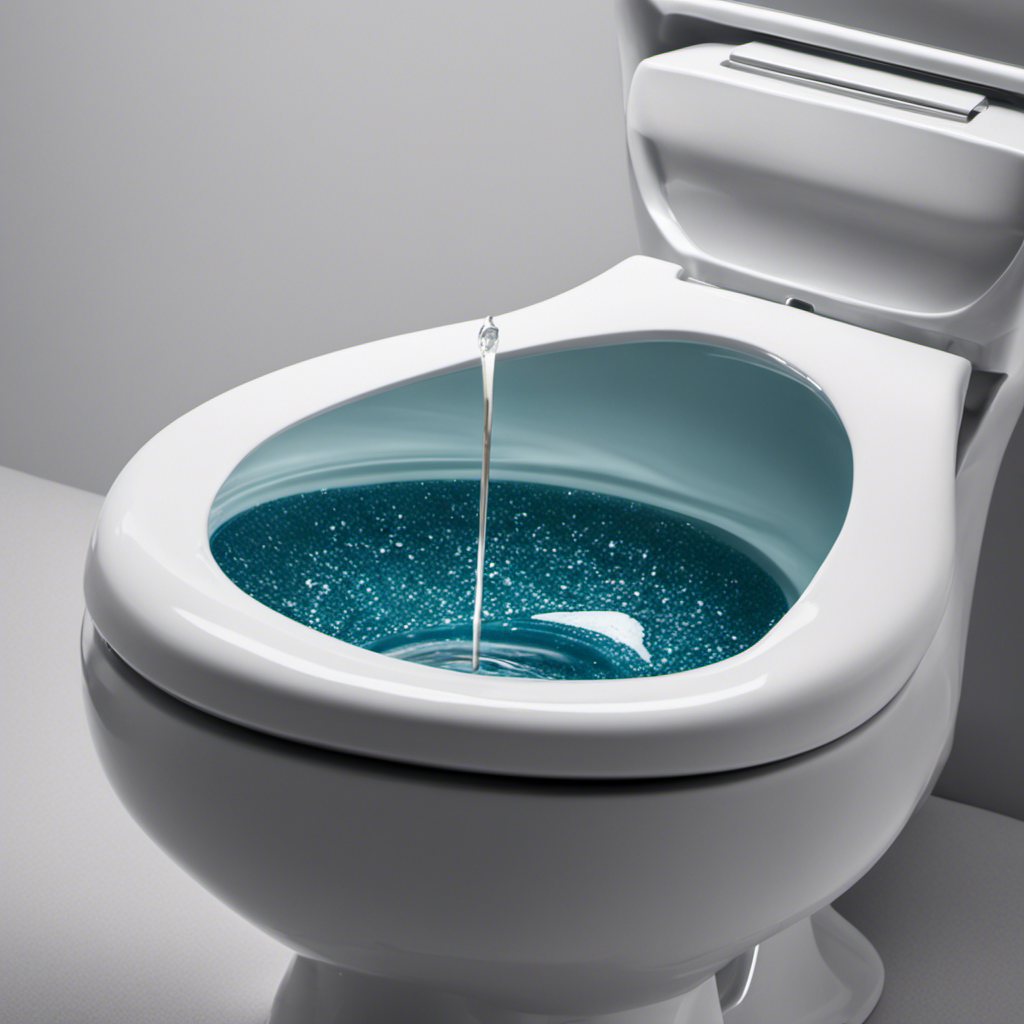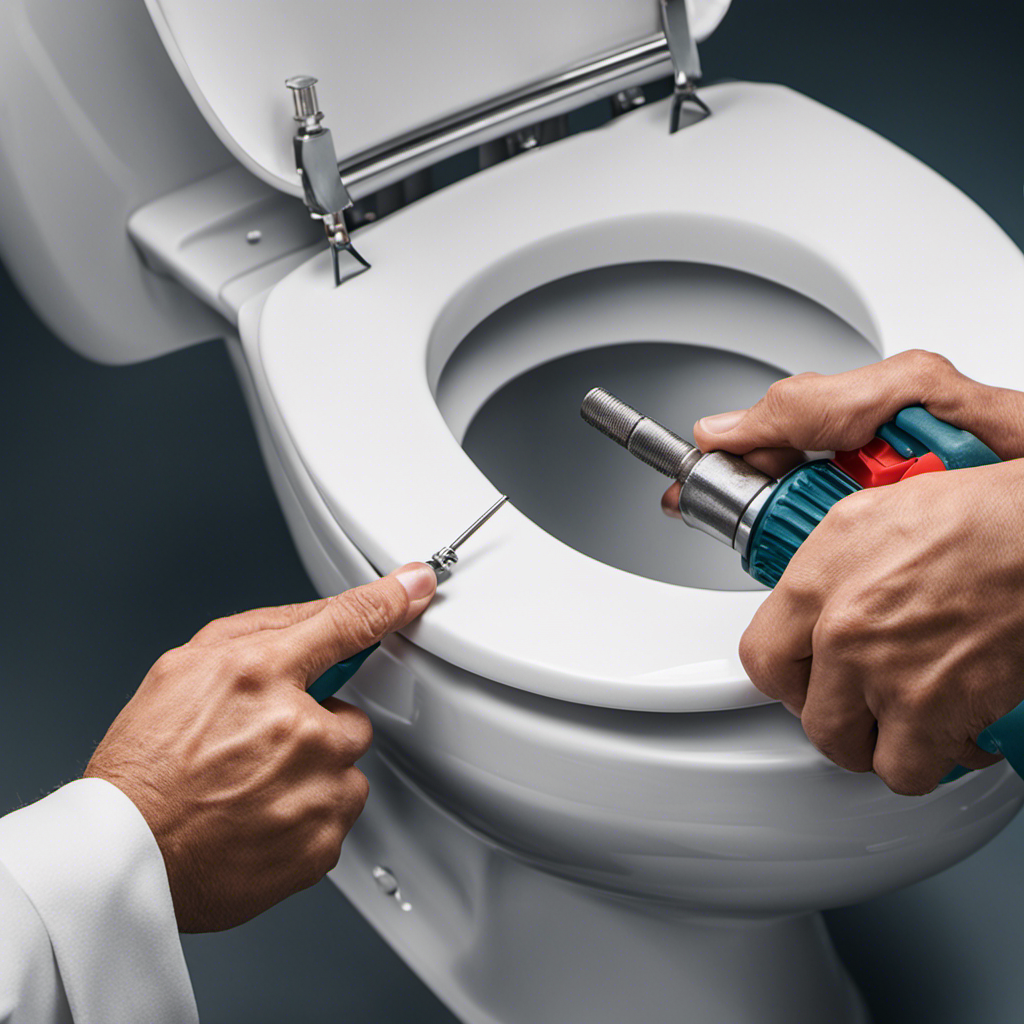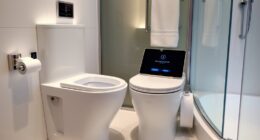Hey there! So, you’re dealing with that pesky limescale buildup below the waterline in your toilet, huh? Well, fear not! I’m here to share my expert tips on how to tackle this stubborn problem head-on.
In this article, I’ll guide you through the best tools to use, provide a step-by-step removal guide, share some natural home remedies, and even offer tips on preventing future limescale buildup.
Trust me, with these tricks up your sleeve, you’ll have a sparkling clean toilet in no time!
Key Takeaways
- Limescale buildup occurs due to the high concentration of minerals in hard water.
- Limescale deposits can cause reduced water flow, clogged pipes, and damage over time.
- Limescale removers containing citric acid or vinegar are effective in dissolving and removing tough mineral deposits.
- Natural remedies like vinegar, baking soda, and lemon juice can be used to naturally and effectively remove limescale deposits.
Understanding Limescale Buildup
Limescale buildup occurs when hard water minerals combine and form a crusty residue. The causes of limescale buildup are primarily due to the high concentration of minerals, such as calcium and magnesium, in hard water. When this water is heated or evaporates, the minerals are left behind and form limescale deposits.
The effects of limescale buildup can be seen in various household appliances, such as kettles, showerheads, and toilets. It can cause reduced water flow, clogged pipes, and even damage to the appliances over time.
While there are various DIY methods for removing limescale, such as vinegar or lemon juice, they may not always be effective. In such cases, professional limescale removal services can provide specialized solutions to completely eradicate the buildup.
Now, let’s explore the best tools for removing limescale.
The Best Tools for Removing Limescale
When tackling the issue of limescale buildup in your toilet, you’ll want to make sure you have the right tools for the job. The best limescale removers are those specifically designed to dissolve and remove tough mineral deposits. Look for products that contain ingredients like citric acid or vinegar, as they are known for their effective cleaning properties.
Additionally, having a toilet brush with strong bristles and a pumice stone can be helpful in scrubbing away stubborn limescale. Remember to always read and follow the instructions on the packaging of any cleaning product you use.
Now that we have the right tools, let’s move on to the step-by-step guide to removing limescale from the toilet below the waterline.
Step-by-Step Guide to Removing Limescale From Toilet Below Waterline
Once you have the right tools, it’s important to start by turning off the water supply to the toilet. This will prevent any water from flowing while you work on removing the limescale below the waterline. Now, let’s dive into some effective limescale removal techniques. One method is to use a mixture of vinegar and baking soda. Simply pour the vinegar into the toilet bowl, followed by the baking soda. Let it sit for a few minutes before scrubbing with a toilet brush. Another option is to use a commercial limescale remover, which can be found at most hardware or home improvement stores. Troubleshooting common toilet limescale issues can be frustrating, but with the right techniques and tools, you can restore your toilet to its former glory.
| Pros | Cons |
|---|---|
| Vinegar and baking soda are natural and safe to use | May require multiple applications |
| Commercial limescale removers are highly effective | May contain harsh chemicals |
| Easy to find ingredients for vinegar and baking soda mixture | Chemical removers can be costly |
| Can be done with regular household items | Chemical removers may have strong odors |
Natural Home Remedies for Limescale Removal
One effective method for tackling limescale buildup in the toilet is to use a mixture of vinegar and baking soda. This natural remedy is both safe and effective in removing limescale deposits.
Using vinegar for limescale removal offers several benefits:
- It is an eco-friendly alternative to harsh chemical cleaners
- Vinegar is readily available and affordable
- It effectively breaks down limescale without causing any damage to your toilet
Another option for limescale removal is lemon juice. Lemon juice contains citric acid, which helps dissolve limescale and leaves a refreshing scent. It is also a natural and non-toxic option for cleaning your toilet.
To use vinegar or lemon juice for limescale removal, simply pour the liquid onto the affected areas and let it sit for a few hours. Then, scrub the area with a toilet brush and rinse thoroughly. Repeat as necessary until the limescale is completely removed.
Preventing Future Limescale Buildup in Your Toilet
To prevent future buildup, regularly clean your toilet bowl with vinegar or lemon juice to keep it free from limescale deposits. These natural ingredients are effective limescale prevention methods and can easily be found in your kitchen pantry.
Simply pour a cup of vinegar or lemon juice into the toilet bowl, scrub with a toilet brush, and let it sit for a few hours. Then, flush the toilet to rinse away the solution and any loosened limescale. This routine maintenance will help keep your toilet free from limescale and prevent it from building up over time.
In addition to regular cleaning, using a limescale prevention product specifically designed for toilets can provide long-term solutions for eliminating limescale. These products create a protective barrier on the toilet bowl, making it easier to clean and preventing limescale from sticking to the surface.
Conclusion
After following the step-by-step guide and using the best tools, I successfully banished the stubborn limescale from my toilet below the waterline.
It was like a victorious battle against the mineral invaders, leaving my toilet sparkling clean and fresh.
With the help of natural remedies, I was able to conquer the enemy without harming the environment.
Now, armed with this knowledge, I will take preventive measures to ensure that limescale never dares to return and tarnish the throne again.










